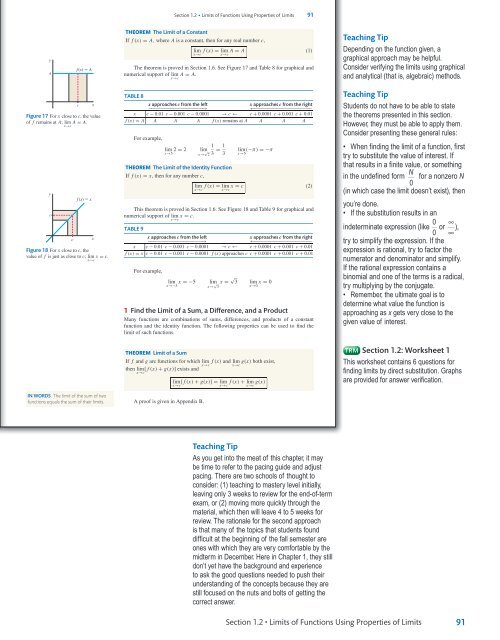Sullivan Microsite DigiSample
You also want an ePaper? Increase the reach of your titles
YUMPU automatically turns print PDFs into web optimized ePapers that Google loves.
<strong>Sullivan</strong> AP˙<strong>Sullivan</strong>˙Chapter01 October 8, 2016 17:4<br />
Section 1.2 • Limits of Functions Using Properties of Limits 91<br />
y<br />
A<br />
f (x) 5 A<br />
THEOREM The Limit of a Constant<br />
If f (x) = A, where A is a constant, then for any real number c,<br />
lim f (x) = lim A = A (1)<br />
x→c x→c<br />
The theorem is proved in Section 1.6. See Figure 17 and Table 8 for graphical and<br />
numerical support of lim<br />
x→c<br />
A = A.<br />
Teaching Tip<br />
Depending on the function given, a<br />
graphical approach may be helpful.<br />
Consider verifying the limits using graphical<br />
and analytical (that is, algebraic) methods.<br />
Figure 17 For x close to c, the value<br />
of f remains at A; lim x→c<br />
A = A.<br />
y<br />
c<br />
c<br />
c<br />
f (x) 5 x<br />
Figure 18 For x close to c, the<br />
value of f is just as close to c; lim x→c<br />
x = c.<br />
x<br />
x<br />
TABLE 8<br />
x approaches c from the left<br />
−−−−−−−−−−−−−−−−−−−−→<br />
x approaches c from the right<br />
←−−−−−−−−−−−−−−−−−−−−−<br />
x c− 0.01 c − 0.001 c − 0.0001 → c ← c + 0.0001 c + 0.001 c + 0.01<br />
f (x) = A A A A f(x) remains at A A A A<br />
For example,<br />
lim<br />
x→5 2 = 2<br />
lim 1<br />
3 = 1 3<br />
x→ √ 2<br />
THEOREM The Limit of the Identity Function<br />
If f (x) = x, then for any number c,<br />
lim(−π) =−π<br />
x→5<br />
lim f (x) = lim x = c (2)<br />
x→c x→c<br />
This theorem is proved in Section 1.6. See Figure 18 and Table 9 for graphical and<br />
numerical support of lim<br />
x→c<br />
x = c.<br />
TABLE 9<br />
x approaches c from the left<br />
−−−−−−−−−−−−−−−−−−−−→<br />
x approaches c from the right<br />
←−−−−−−−−−−−−−−−−−−−−−<br />
x c− 0.01 c − 0.001 c − 0.0001 → c ← c + 0.0001 c + 0.001 c + 0.01<br />
f (x) = x c− 0.01 c − 0.001 c − 0.0001 f (x) approaches cc+ 0.0001 c + 0.001 c + 0.01<br />
For example,<br />
lim<br />
x→−5 x =−5<br />
lim<br />
x→ √ x = √ 3<br />
3<br />
lim x = 0<br />
x→0<br />
1 Find the Limit of a Sum, a Difference, and a Product<br />
Many functions are combinations of sums, differences, and products of a constant<br />
function and the identity function. The following properties can be used to find the<br />
limit of such functions.<br />
Teaching Tip<br />
Students do not have to be able to state<br />
the theorems presented in this section.<br />
However, they must be able to apply them.<br />
Consider presenting these general rules:<br />
• When finding the limit of a function, first<br />
try to substitute the value of interest. If<br />
that results in a finite value, or something<br />
in the undefined form N for a nonzero N<br />
0<br />
(in which case the limit doesn’t exist), then<br />
you’re done.<br />
• If the substitution results in an<br />
indeterminate expression (like 0 0 or ∞ ∞ ),<br />
try to simplify the expression. If the<br />
expression is rational, try to factor the<br />
numerator and denominator and simplify.<br />
If the rational expression contains a<br />
binomial and one of the terms is a radical,<br />
try multiplying by the conjugate.<br />
• Remember, the ultimate goal is to<br />
determine what value the function is<br />
approaching as x gets very close to the<br />
given value of interest.<br />
IN WORDS The limit of the sum of two<br />
functions equals the sum of their limits.<br />
THEOREM Limit of a Sum<br />
If f and g are functions for which lim f (x) and lim g(x) both exist,<br />
x→c x→c<br />
then lim[ f (x) + g(x)] exists and<br />
x→c<br />
A proof is given in Appendix B.<br />
lim[ f (x) + g(x)] = lim f (x) + lim g(x)<br />
x→c x→c x→c<br />
TRM Section 1.2: Worksheet 1<br />
This worksheet contains 6 questions for<br />
finding limits by direct substitution. Graphs<br />
are provided for answer verification.<br />
Teaching Tip<br />
As you get into the meat of this chapter, it may<br />
be time to refer to the pacing guide and adjust<br />
pacing. There are two schools of thought to<br />
consider: (1) teaching to mastery level initially,<br />
leaving only 3 weeks to review for the end-of-term<br />
exam, or (2) moving more quickly through the<br />
material, which then will leave 4 to 5 weeks for<br />
review. The rationale for the second approach<br />
is that many of the topics that students found<br />
difficult at the beginning of the fall semester are<br />
ones with which they are very comfortable by the<br />
midterm in December. Here in Chapter 1, they still<br />
don’t yet have the background and experience<br />
to ask the good questions needed to push their<br />
understanding of the concepts because they are<br />
still focused on the nuts and bolts of getting the<br />
correct answer.<br />
Section 1.2 • Limits of Functions Using Properties of Limits<br />
91<br />
TE_<strong>Sullivan</strong>_Chapter01_PART 0.indd 20<br />
11/01/17 9:52 am




